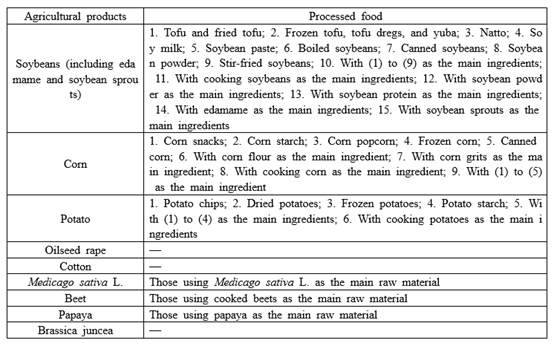Since the 1980s, humans have been consuming genetically modified foods for more than 40 years. Various countries have also formulated corresponding regulations and policies for genetically modified foods. Antion will introduce the supervision and labeling requirements for genetically modified foods in Japan.
Definition of genetically modified food in Japan
The relevant information of the Ministry of Health, Labour and Welfare of Japan defines genetically modified crops as those are obtained by gene editing using genes extracted from other organisms. Foods with these genetically modified crops are genetically modified foods.
Labeling requirements for genetically modified foods in Japan
1. Object
According to the relevant provisions of Japan's Standard for Food Labeling, as of July 2023, the Ministry of Health, Labor and Welfare has announced 9 categories of genetically modified foods that have passed the safety review, including soybeans (containing edamame and soybean sprouts), corn, potatoes, oilseed rape, cotton, Medicago sativa L., beets, papaya and Brassica juncea, involving 33 processed foods.

According to the Questions and Answers on Standard for Food Labeling, soy sauce, dressing, rapeseed oil, corn chips and other foods that have undergone processes such as fermentation, distillation and heat treatment and whose recombinant genes are broken down and removed and cannot be detected, are not within the scope of objects that need to be marked.
2. Labeling methods for GMO
According to the relevant provisions of Japan's Standard for Food Labeling, the labeling methods for genetically modified foods are as follows:
a. When the target raw material is genetically modified, brackets should be added after the target raw material to indicate that the raw material is genetically modified; for example: soybean (genetically modified).
b. If the target raw material is not under production and circulation management, it is impossible to distinguish between GMO and non-GMO foods, parentheses should be placed after the target raw material to indicate that the material does not distinguish between GMO and non-GMO; For example: soybeans (not classified from GMO soybeans/not distinguish GMO).
c. If the target raw materials are confirmed to be non-GMO, only the target raw materials may be indicated, or brackets may be added after the target raw materials to indicate that the material is non-GMO.
d. When the labelable area of prepackaged food is less than 30 square centimeters, it is exempted from labeling relevant information on genetically modified organisms.
e. For high oleic soybeans, high lysine corn, linoleic acid-producing soybeans that are subject to specific classification production and circulation management, and foods processed with these as raw materials, mandatory labeling is required; for example: soybeans (high oleic genetically modified/ high oleic genetically modified hybrid).
3. Arbitrary labeling
For GMO foods that have gone through the differentiated production management and circulation process, GMO foods with a GMO contamination rate of less than 5% can be labeled as "differentiated management to prevent GMO food raw materials from being mixed in", for example: soybeans (classified to prevent GM contamination);
Genetically modified foods with a 0% mixing rate (i.e., no detection) can be labeled as "non-genetically modified foods". This labeling method is only allowed when genetically modified ingredients cannot be detected. For example: soybeans (non-genetically modified).
Requirements for claims of genetically modified foods in Japan
1. The above nine types of genetically modified agricultural products and processed foods with the above nine types of genetically modified agricultural products as main ingredients* specified in the Standard for Food Labeling must compulsorily carry a "genetically modified" claim.
*Main raw material refers to the raw material that ranks among the top 3 in terms of quantity and accounts for more than 5% of the total weight of the processed food.
2. For products such as soy sauce, soybean oil, and corn oil, since the DNA or protein from genetically modified organisms is decomposed and removed during the production process, genetically modified ingredients cannot be detected in the final product, and enterprises can choose whether to make a "genetically modified" claim. However, for high-oleic soybeans, high-lysine corn, linolenic acid-producing soybeans, and foods processed with these as raw materials, a "genetically modified" claim must be made.
3. For the above 9 categories of non-GMO agricultural products and processed products, enterprises can voluntarily claim to be "non-GMO"; if they are not managed differently, they can claim to be "managed in the same way as GMO".
4. Currently, the Ministry of Health, Labor and Welfare of Japan has only approved the above-mentioned 9 categories of genetically modified agricultural products and their processed products, so other agricultural products and processed foods such as rice and wheat are not allowed to claim to be "non-GMO".
Source: Antion
Note: This article is compiled by Antion. Please indicate the source for reprint.